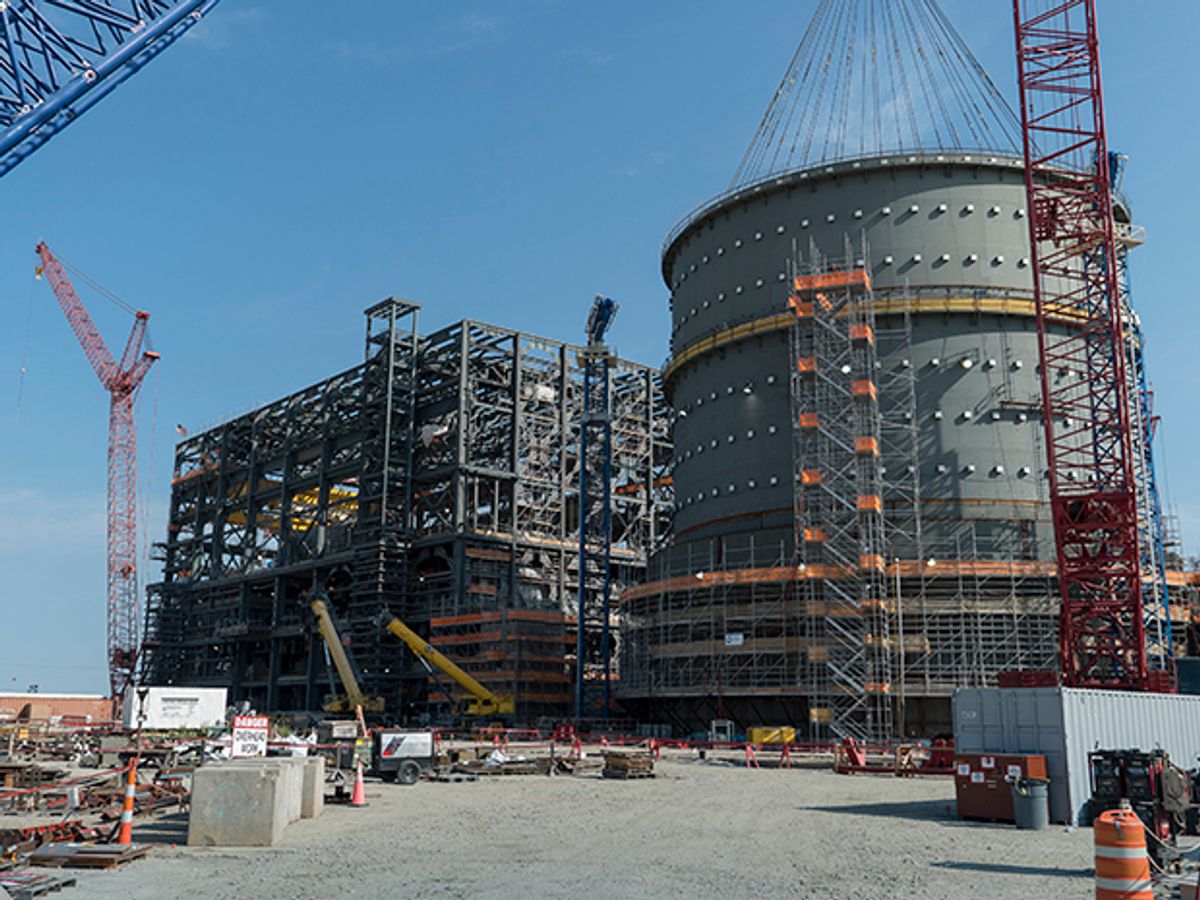“Public trust is at stake here, folks.” That’s how South Carolina’s top power industry regulator described the gravity yesterday of local utilities’ decision to walk away from a pair of partially-built nuclear reactors, according to Charleston’s Post and Courier newspaper. Public Service Commission chairman Swain Whitfield added that the reactors’ cancellation after $9 billion of investment — more than the state’s annual budget — “is going to shatter lives, hopes and dreams” in South Carolina.
South Carolina-based Santee Cooper and SCANA’s abandonment of their pair of new reactors, announced on Monday, also have broader ramifications for the nuclear industry’s self-declared “nuclear renaissance.” In March the cost overruns and delays afflicting this project and a sister project in Georgia drove the reactor designer and builder Westinghouse Electric Co. into bankruptcy. Cost overruns and political concerns are also squeezing nuclear suppliers from France, South Korea, and Russia.
South Carolina’s reactor fiasco mirrors the financial blowouts and shoddy fabrication of the 1970s that sparked a 30-year hiatus in U.S. nuclear power construction. The VC Summer project [PDF] started out as a $10 billion effort, but its owners now project that completing it would cost over $20 billion; the price could be $25 billion, according to the Post and Courier.
Construction is continuing (for now) for new reactors at Georgia’s Vogtle power plant led by Atlanta-based utility Southern Co. But they too are in trouble. In March Morgan Stanley estimated that the project would cost $18.9 billion—double its original price tag. Southern’s board is to decide later this month whether to halt it.
All of the reactors use Westinghouse’s AP1000 design, which is supposed to be meltdown-proof thanks to a tank of cooling water positioned above the reactor and improved air circulation. In 2015 Southern CEO Thomas Fanning told Bloomberg News that its pair of Westinghouse AP1000 reactors would be, “one of the most successful megaprojects in modern American industrial history.”
Instead the new reactors have humbled Westinghouse. The financial fallout continues to challenge Toshiba, Pittsburgh-based Westinghouse’s Japanese parent company; some banks and shareholders are urging it to consider bankruptcy protection according to The Register.
Back in South Carolina there will be plenty of wrangling in the years ahead over who bears the blame and who should cover the wasted investment. SCANA and Santee Cooper plan to seek assets from the Westinghouse bankruptcy and have been guaranteed over $2.1 billion in compensation by Toshiba.
Santee Cooper CEO Lonnie Carter is also sharing some blame with President Trump and his planned pullback from President Obama’s Clean Power Plan, which promised incentives for states building new nuclear. “If you really believe that we need to reduce carbon, this was the way to do it,” said Carter on Monday.
Environmental groups, however, say new reactors are not a cost-efficient solution to climate change, and put the blame squarely on the utilities’ executives such as Carter. “Foul-ups and inferior quality plagued the construction from the outset… Prudent management would have recognized that the project was doomed by mid-2016 and pulled the plug,” writes Mark Cooper, senior fellow at Vermont Law School’s Institute for Energy and the Environment, in a report last month commissioned by the Sierra Club and Friends of the Earth. They are petitioning the Public Service Commission to protect state ratepayers, who have already been charged nearly $2 billion in advance for power that the reactors will never generate.
Aborted reactors are not only a risk in the United States. South Korean President Moon Jae-in, elected in May on an anti-nuclear platform, halted construction of two Korean reactors that are 30 percent complete. A “citizens’ jury” composed of ten disinterested panelists will consider whether to permanently abandon them.
A vote in favor of a shutdown could crater the export prospects for nuclear supplier Korea Electric Power Corporation. “Nations are highly unlikely to buy nuclear plants from a nation that is phasing them out domestically,” argues nuclear advocate Michael Shellenberger in a blog post last month for Environmental Progress, the pro-nuclear nonprofit that he runs.
Then there is France’s nuclear technology champion Areva, recently saved by a €4.5 billion ($5.1 billion) rescue package from the French government, which is struggling to complete its first EPR reactors. Those began construction in Finland and France in 2005 and 2007, respectively, and are both years behind schedule and massively over budget.
The EPR in France, which is being built by Paris-based utility Electricité de France (EDF), narrowly escaped potential cancellation in June. France’s nuclear safety authority determined that it could operate in spite of substandard steel in its reactor pressure vessel, which has already been installed at the site.
EDF recently adjusted expectations for a pair of EPRs it is building the UK, saying that project was at least £1.5 billion ($1.95 billion) over budget. It also said the first reactor might be completed in 2027 rather than 2025. In June the U.K.’s National Audit Office released a report arguing that government price guarantees well above current power rates had “locked consumers into a risky and expensive project with uncertain strategic and economic benefits.”
The U.K. government has offered similar guarantees for a trio of AP1000 reactors that Toshiba was to build at another site. In May a report in Yale Environment 360 said those now “look doomed because of the financial implosion of the company.”
Peter Fairley has been tracking energy technologies and their environmental implications globally for over two decades, charting engineering and policy innovations that could slash dependence on fossil fuels and the political forces fighting them. He has been a contributing editor with IEEE Spectrum since 2003.



